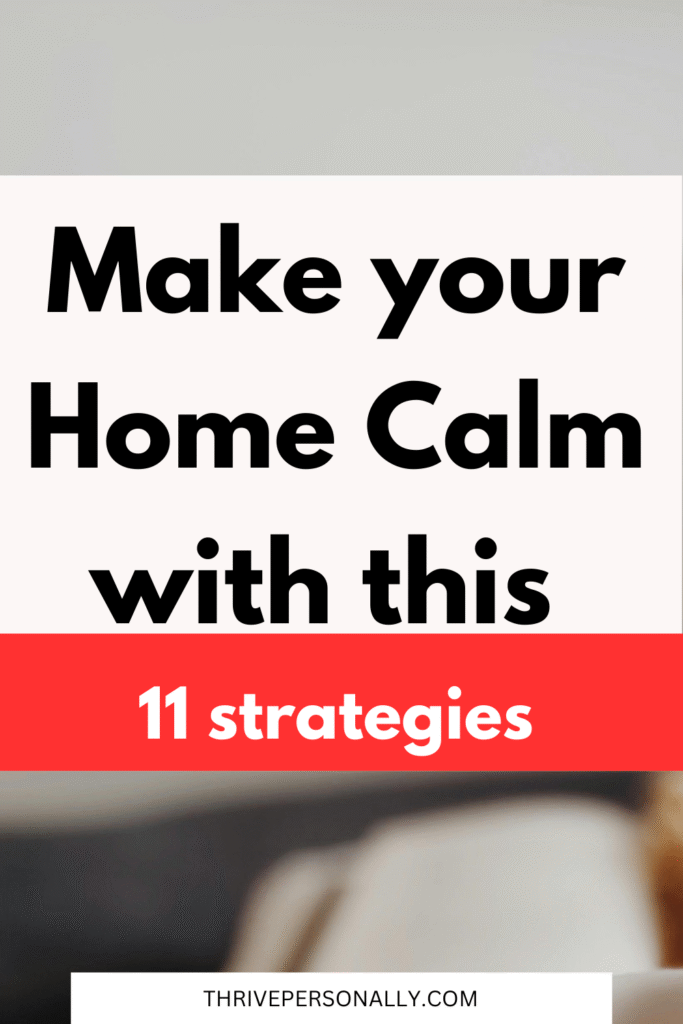In today’s world, your home can either feel like a refuge or another source of stress. Noise, clutter, pressure, and even the energy of a room can weigh on your mind. When you spend a lot of time in a space that feels tense or messy, your mood and your mental health often begin to mirror that tension. That’s why creating a calm space at home is not just about decoration or comfort. It’s about mental clarity, emotional stability, and healing.
A calm space gives you room to breathe, think, and feel without constant pressure or overstimulation. It doesn’t have to be a large room or a quiet house. It can be a small corner of your bedroom, a chair by a window, or even your bathroom. What matters is how the space makes you feel and what it allows you to do. A calm space helps you slow down, refocus, and handle life with more patience and strength.
In this post, we’ll look at 11 simple ways to create that calm, soothing energy in your home. Each one can be done at your own pace and with items you already have or can find easily. You’ll learn how to shape your environment into one that supports your emotional health rather than drains it.
1. Begin with Decluttering What You See
The first step to calm is removing what adds to stress. That usually means clutter. When too many things are in one place—especially things you don’t use or love—they create noise for the brain. It becomes hard to focus or relax.
Look around your space and pick a surface—like a desk, shelf, or nightstand. Start there. Remove anything that doesn’t serve a purpose. You don’t have to throw things away right now. Just move them out of sight. The goal is to reduce what your eyes take in at once.
According to Mayo Clinic Health System, visual clutter increases mental clutter. The brain prefers clean, open areas because they signal safety and rest. A single cleared shelf can shift the entire mood of a room.
Read also: Want a Tidy Home? Here Are 10 Smart Decluttering Tips
2. Use Natural Light When You Can
Light affects your mood more than you may realize. Harsh artificial lighting can increase stress or even trigger headaches. But soft natural light helps the body relax. It balances your sleep cycles and improves your mood during the day.
If your windows have heavy curtains, consider opening them during the day. If your space doesn’t get much sunlight, use warm-toned bulbs instead of bright white ones. Also, placing mirrors in areas that reflect light can make a room feel more open and calm.
Creating light that soothes doesn’t require big changes. Even a small lamp with a warm glow can shift how a room feels. The goal is to soften the edges of your environment so your mind can settle, not stay on alert.
Read also: 10 Simple Ways to Declutter Your Life
3. Choose Soothing Colors
Colors speak directly to your emotions. Bright reds or neon’s can energize you, but they don’t always bring calm. Colors like soft blue, pale green, off-white, or muted earth tones tend to have a calming effect.
You don’t need to repaint your walls. You can bring calm tones in through bedsheets, pillowcases, rugs, or even a blanket draped over a chair. Small touches of color placed where your eyes land the most—like near your bed or work area—can shift how you feel when you enter that space.
Psychologists have studied the link between color and emotional balance. Cool, soft colors help reduce blood pressure and slow your heart rate. That makes it easier for your body and mind to return to a place of calm.
Read also: Making Career Choices When Passion is Lacking
4. Use Gentle Scents to Support Relaxation
Your sense of smell connects deeply with your emotional brain. Certain scents can ease stress, help you sleep better, or even improve your focus. You can use candles, essential oils, natural herbs, or even fresh fruit to bring calm into your space.
Some people respond well to lavender, while others prefer mint, lemon, or sandalwood. You don’t need a diffuser or expensive oils. A bowl of dried herbs, a scented lotion, or even citrus peels in a cup of water can offer a refreshing scent.
The point isn’t to fill the space with strong smells but to use gentle scent as a background support. Over time, your brain begins to associate that scent with safety, rest, and ease.
5. Add Soft Textures Around You
Textures affect how relaxed your body feels. If your space is full of sharp, cold, or hard surfaces, your nervous system stays slightly alert. But when you add softness—like a fuzzy blanket, a soft chair, or cushioned slippers—your body relaxes.
You can start small. Place a soft throw pillow in your chair. Use a cozy rug by your bed. Lay a soft towel or blanket across the space where you sit. Touch invites calm. Soft textures are not about style. They’re about comfort. And comfort helps the mind feel safe.
This idea connects to your body’s natural response to softness. When your skin feels comforted, your brain sends signals that it’s safe to relax.
6. Keep a Few Calming Items in View
One way to build a calm space is to keep items nearby that ground you. These are objects that remind you of peace, care, or meaning. It could be a photo, a book, a plant, a handwritten note, or even a stone you picked up on a walk.
Don’t overcrowd your space with decorations. Just pick two or three items that make you breathe a little easier when you look at them. Place them somewhere you often rest your eyes—like on your nightstand, shelf, or windowsill.
These personal items help you stay connected to your own story. They also remind you that the space is yours. A calm space is not just tidy—it’s personal.
7. Reduce Noise or Add Soft Sounds
Noise pollution can make a space feel tense without you even noticing it. Sounds like traffic, television, or loud talking in another room can pull your attention away and wear you out. A calm space needs quiet—or at least a sound that brings peace.
If you can, lower the volume of background devices. Use soft background music, nature sounds, or white noise to block out stress. Some people use sound machines or play gentle playlists when reading or winding down.
Even silence itself is powerful. Giving yourself a quiet corner—away from the noise of screens or people—helps your mind breathe and recharge.
8. Set Boundaries Around the Space
It’s hard to feel calm in a space where people interrupt you or where you feel like you need to be “on.” One of the most powerful ways to keep a calm environment is to protect it. That means setting clear boundaries.
If possible, let others in your home know when you need quiet time in your space. This might be 10 minutes of stillness after work, or one hour in the evening to sit, read, or stretch. It’s not about avoiding people—it’s about caring for your energy.
When you protect your space, it begins to protect you. You no longer enter that area with tension. You begin to trust it as a place of restoration.
9. Clean the Air with Plants or Fresh Air
Plants add more than beauty to a room. They also improve air quality and give your brain something gentle to focus on. Even one small plant can change the feeling of a room.
If you don’t have plants, opening a window to let in fresh air works just as well. Stale air holds old energy. Fresh air helps reset a space. It also signals to your body that it’s safe, clean, and ready for rest.
According to NASA’s Clean Air Study, many common plants help remove toxins from indoor air and provide oxygen. Even if your space is small, a bit of nature makes it easier to breathe—literally and emotionally.
10. Keep Your Calm Space for Rest, Not Work
If possible, try not to use your calm space for stressful tasks. This might mean not answering work calls in that chair or not bringing a laptop into that area. Your brain links certain places to certain actions. If you do stressful things in your calm space, it stops feeling like a place of rest.
This isn’t always possible in small homes, but even a tiny shift helps. Maybe you use a candle, a soft blanket, or a certain light only when it’s time to relax. Over time, your brain begins to understand that when those things are present, it’s time to slow down.
Creating clear roles for your space—even if it’s just a corner—helps you reset faster. It becomes easier to feel at ease because your body remembers what this space is for.
11. Return to the Space Often and With Intention
The last step isn’t about how the space looks—it’s about how you use it. A calm space becomes powerful only when you return to it. Not just when you feel overwhelmed, but also during calm moments. Make it part of your routine.
Sit in your space in silence. Breathe there. Read there. Drink tea. Write a note to yourself. Stretch your body. Let the space become familiar and safe, not just a last resort. That way, when things go wrong, your body already knows where to go to begin healing.
According to research from the American Psychological Association, people who regularly return to calming environments handle stress better and bounce back faster. Your calm space becomes a place of emotional training—a shelter that builds your strength.
Final Thoughts: Calm Is a Practice, Not a Perfect Picture
Creating a calm space isn’t about making your home look like a magazine. It’s not about being minimalist or rich or creative. It’s about listening to what makes you feel grounded. Safe. Soft. Rested.
It can be one chair, one shelf, or one blanket. What matters is that it helps you return to yourself. You don’t need to wait for life to slow down before you build calm around you. You start with what you have. A little light. A little softness. A little silence. And slowly, your space becomes a tool for peace.
Every time you sit in that space, you’re doing more than resting. You’re reminding your body that healing is allowed here. That it’s okay to let go, breathe, and just be.



